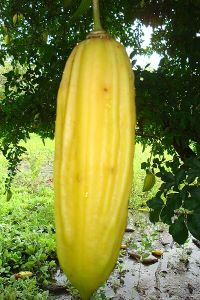Cuajilote: The Latin American cucumber
By Odette Olivares, MCN, VRG volunteer
Current food systems are based on a small number of foods due to production and market practicalities despite nature having a wide variety of amazing edible plant foods that most of the time go unnoticed by modern societies. While agricultural markets sell what has highest demand and represent highest earnings, consumers tend to concentrate their food choices on popular sold foods with low prices.
For example, rice, wheat, and corn are the most consumed cereals worldwide, although there are around 35 types of cereals.1 Unfortunately, this production model increases the vulnerability of food security by losing a rich plant diversity needed when facing the adverse agricultural growing conditions due to Climate Change. By losing this diversity, we are also losing the opportunity of utilizing the therapeutic properties of unexplored foods. Fortunately, we can recover a lot of incredible foods from old villages and indigenous communities’ knowledge, which fortunately preserve their food traditions. This is the case of Cuajilote.2
Cuajilote derives from Nahuatl. “Cuahuitl” means tree and “xilotl,” corn silk. Also called Kat ku’uk, kat cucumber, or guajilote, it is a fruit that physically resembles conventional cucumber types, because of its color and long shape. However, cuajilote belongs to the Bignoniaceae family, and the conventional cucumber to Cucumis sativus L. Other differences lie in flavor, texture, and length. Cuajilote’s flavor is sweet and very versatile. It is a fundamental ingredient of “salpimentado,” a Yucatecan broth, but it can also be eaten fresh, roasted, in syrup, or in salads.3 Both salty and sweet dishes go well with it.
Nutrition-wise, it has a lot to offer too. For every 100 g, it has 5 g of protein, 21 g of fiber, 55 mg of calcium, and 9 mg of iron. It also contains thiamin, riboflavin, niacin, carotenes, and vitamin C.3 It is rich in antioxidants and polyphenols which depend on its degree of ripeness.4 The indigenous and rural community state the infusion of cuajilote’s roots can serve as diuretic and to tackle colds, diabetes, renal insufficiency, headaches, gallstones, and diarrhea.4 Currently, scientific studies are being conducted to explain the mechanisms behind these therapeutic uses and to determine more treatment details. So far, its antioxidants and polyphenols content might be responsible for the therapeutic uses that have been attributed to it.4
If you ever have the opportunity to try cuajilote, here I provide you with a recipe based on the traditional way of eating the cuajilote as dessert in Yucatán, México.
Caujilote Candy
Ingredients:
4 cuajilotes
2 piloncillos (a raw form of pure cane sugar found in the Latino section of stores)
2 cups water
3 sticks cinnamon
4 Tablespoons soy cream
Procedure:
- Peel and cut the cuajilote into small slices.
- Heat the piloncillo, water, and cinnamon together for a few minutes to create a syrup.
- Add the chopped cuajilote to the syrup and keep heating for 45 minutes, till the cuajilote is cooked.
- Serve with soy cream on top.
References
1 U.S. Forest Service. Cereal, Grasses, and Grains. Forest Service Shield. Accessed February 18, 2024. https://www.fs.usda.gov/wildflowers/ethnobotany/food/grains.shtml.
2 Castillo-Ruíz R, Castillo-Archila JA, Alemán-Castillo SE, Castillo-Ruiz O, Trejo-Díaz GN. Alternativas para el Aprovechamiento del Cuajilote (Parmentiera edulis): Una Especie Agroindustrial Subutilizada. CienciaUAT. 2022;17(1):123-138. doi:10.29059/cienciauat.v17i1.1635
3 Domínguez JC, Herrera G. Una delicia en el árbol: el pepino kat. https://www.cicy.mx/Documentos/CICY/Desde_Herbario/2018/2018-07-12-Dominguez-&-Herrera-una-delicia-en-el-arbol.pdf
4 Santiago Ruiz C, Nuricumbo Lievano VN, Chapa Barrios MG, Vela Gutiérrez G, Velázquez A. Antimicrobial activity, phenolic and antioxidant content of extracts from Cuajilote (Parmentiera Aculeata Kunth) fruits at different degrees of ripening. Journal of the Mexican Chemical Society. 2021;65(2). doi:10.29356/jmcs.v65i2.1270
Read more from Odette at
https://www.vrg.org/journal/vj2023issue1/2023_issue1_foods_high_in_iron.php
and
https://www.vrg.org/journal/vj2021issue2/2021_issue2_latin_american_calcium.php
The contents of this posting, our website and our other publications, including Vegan Journal, are not intended to provide personal medical advice. Medical advice should be obtained from a qualified health professional. We often depend on product and ingredient information from company statements. It is impossible to be 100% sure about a statement, info can change, people have different views, and mistakes can be made. Please use your best judgment about whether a product is suitable for you. To be sure, do further research or confirmation on your own.

